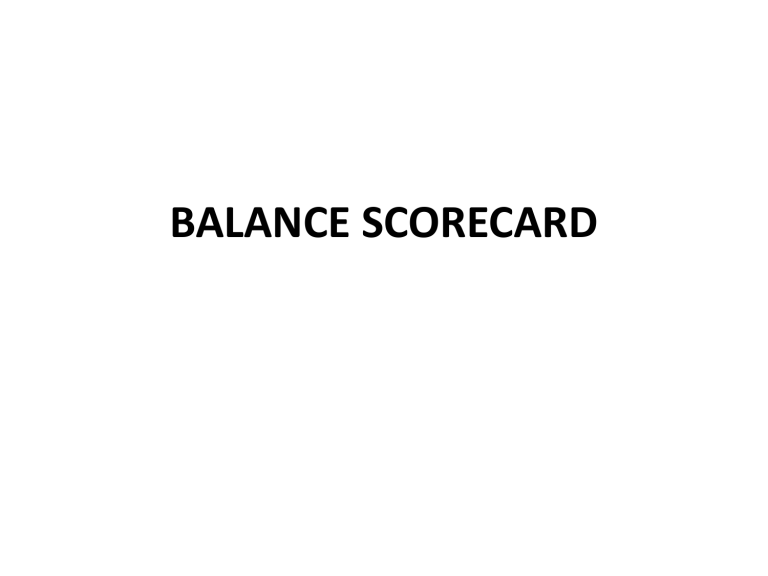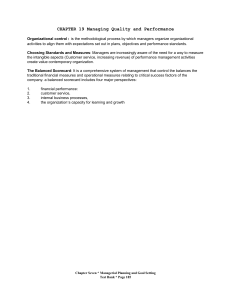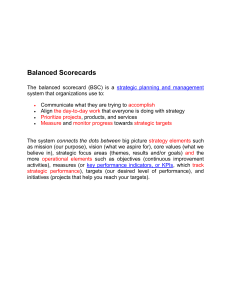
BALANCE SCORECARD INTRODUCTION •A new approach to strategic management was developed in the early 1990's… • by Drs. Robert Kaplan (Harvard Business School) and David Norton. •They named this system the 'balanced scorecard'. Rationale •Growing dissatisfaction with traditional, financial measures of performance. •These measures suffer from a number of serious drawbacks: oshort-term view ohistoric view of performance. Rationale Cont. • The shift towards flexible production/service systems and lean • requirement for performance measurement systems to become more broadly based, • incorporating both non-financial and external measures of performance. Lean production is an approach to mgt that focuses on cutting out waste, whilst ensuring quality. Importance of the Scorecard • it provides a better assessment of performance. • It enables companies to track financial results while simultaneously monitoring non financial performance. • Is a management system that enables organizations to clarify their vision, strategy and translate them into action. BALANCED SCORECARD Four Perspectives • • • • The Customer Perspective The Business Process Perspective The Innovation and Learning Perspective The Financial Perspective Perspective Customer Internal Business Innovation and learning Financial Question Explanation What do existing and new Gives rise to targets that matter customers value from us? to customers: cost, quality, delivery, inspection, handling and so on. What processes must we Aims to improve internal excel at to achieve our processes and decision making. financial and customer objectives? Can we continue to improve Considers the business's capacity and create future value? to maintain its competitive position through the acquisition of new skills and the development of new products. How do we create value for Covers traditional measures such our shareholders? as growth, profitability and shareholder value but set through talking to the shareholder or shareholders direct. CHARACTERISTICS OF BALANCED SCORECARD 1. It is a top-down reflection of the company’s mission and strategy. 2. It is forward-looking. It addresses current and future success. 3. It integrates external and internal measures 4. It helps you focus: balanced scorecard requires managers to reach agreement on only those measures that are most critical Example Financial Perspective Customer Perspective GOALS Survive MEASURES Cash flow GOALS New Product MEASURES Percentage of sales from new products Succeed Monthly sales growth and operating income by division Responsive supply On-time delivery (defined by customer) Increase market share and ROI Preferred Supplier Share of key accounts purchases Ranking by key accounts Customer partnership Number of cooperative engineering effort Prosper Internal Business Perspective GOALS Technology capacity MEASURES Manufacturing configuration vs competition Manufacturing Cycle time excellence Unit cost Yield Innovation and Learning Perspective GOALS Technology leadership Silicon efficiency Engineering efficiency New product Actual introduction introduction schedule vs plan Time to develop next generation of products Manufacturing Process learning maturity Product focus Design productivity MEASURES time to Percentage of products that equal 80% sales Time to market New introduction competition product vs READ ON Balanced Scorecard Organizations and Not-For-Profit Question Spotlight Productions has in the past produced just one fairly successful product. Recently, however, a new version of this product has been launched. Development work continues to add a related product to the product list. Given below are some details of the activities during the month of November. Units produced – existing product – new product 25,000 5,000 Cost of units produced – existing product GH¢375,000 – new product GH¢70,000 Sales revenue – existing product GH¢550,000 – new product GH¢125,000 Hours worked – existing product – new product Development costs 5,000 1,250 GH¢47,000 Required (a) Suggest and calculate performance indicators that could be calculated for each of the four perspectives on the balanced scorecard. (b) Suggest how this information would be interpreted. Clue Customer: Percentage of sales of new product to total sales 18.5% Internal: • Productivity (Hrs/unit) Existing = 5 units per hour New Product = 4 units per hour • Unit cost (Cost/unit) Existing = $15 per unit New Product = $14 per unit Financial: Gross profit =(turnover-cost)/turnover Existing = 32% New Product = 44% Innovation and learning: Development costs as development cost/total turnover = 7% THANK YOU



